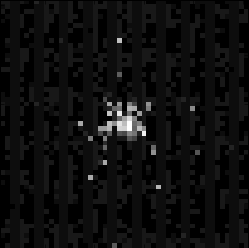What is Swift?
Swift is a satellite designed to look at GRBs, and it has some innovative technology to help it do that.

The Burst Alert Telescope, or BAT, can see about 1/6 of the sky at any given time. It looks out for the flash of Gamma Rays which means a new GRB has gone off. As soon as it detects this BAT tells people on the ground (most of us get a text message on our phones) and tells the spacecraft. The spacecraft checks whether it's safe to point at the burst (it's not too close to the Sun or Moon, for example) and if so immediately, and auotmatically spins round to point at it. This usually takes about a minute; before Swift observations of a new GRB usually started hours after the burst!

Once Swift is pointing at the new burst, the X-ray telescope (XRT) and UV/optical telescope (UVOT) start taking data. In nearly every case the XRT finds the burst, and about half of them are detected by the UVOT as well. The first thing the XRT does is take a quick image and try to work out where the GRB is. This is really important because, although the BAT can see a lot of the sky it isn't brilliant at working out where things that it sees are. All instruments give us a circle and say "the object is in that circle somewhere." (see Positions in Space for more information). For BAT, that circle is 3 arc minutes in radius; about the size of a pinhead half a metre away. That sounds small, but there are a lot of stars and galaxies in a circle that size. If the XRT manages to find a source in that quick image (an example is on the right) it can improve the position to a circle more like 5" across (a pinhead 20 metres away). This allows ground-based observers with big telescopes to look in earnest for the GRB.
After the initial image, both XRT and UVOT continually take data and send some of it to the ground immediately so that the Swift team (people like me!) can learn a few things about the burst (how bright is it, is it fading, determine an even more accurate position) and produce a circular -- an e-mail that gets sent to about 1000 interested scientists around the world. This circular needs to be sent within about 20 minutes of the BAT detecting the burst, no matter what time of day or night it happens. One of my jobs has been helping to automate as much of the writing of this circular as we can, so that even at 3:30 am when we've just been woken up, we can get accurate information out quickly.
What happens next?

Once every orbit (96 minutes) Swift passes over the Malindi ground station in Kenya, and then it dumps all of the data it's taken, not just the limited versions which were available in real time. This is analysed by the Swift who make it available on line and send more circulars to tell the scientific community what's going on. Many other astronomers will be using ground-based telescopes to look for the burst, to learn about its spectrum (what colour it is, only is great detail), how far away it is, if we can locate it even more precisely, and so on. Every day the Swift team have a teleconference to plan what targets Swift will observe, and Swift will usually follow a GRB for as long as we can detect it. This can in some cases be many months! The image to the left shows a "light curve" -- a graph of how bright the source was as time went on -- for GRB 060729. This burst was detected by Swift's XRT for more than 100 days! Usually GRBs are detected for longer in X-rays than in the optical. One of my jobs has been to make sure that, as long as we look at a GRB, the XRT data are automatically analysed and posted online.
I've created a separate page giving a timeline of a typical GRB for people who are interested.
Further information: From swift.ac.uk | From NASA.